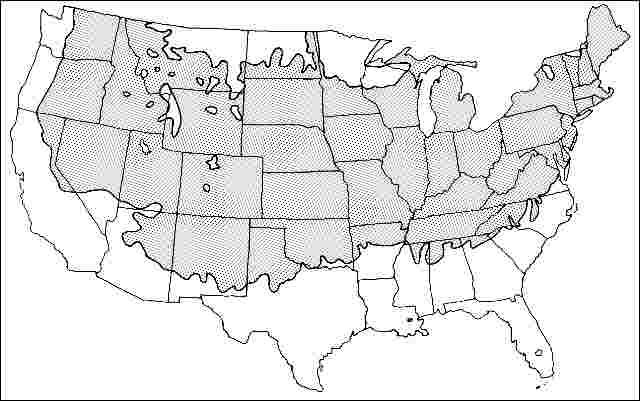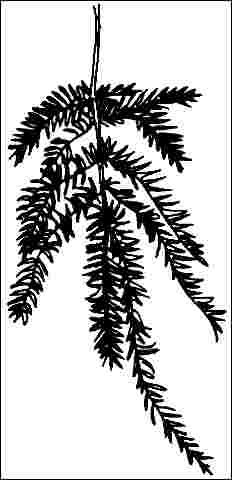Introduction
Canadian hemlock may be one of the most beautiful conifers, with its soft green needles attached to gently arching branches, often reaching to the ground. Specimen trees look their best with lower branches left on and touching the ground. The strong, conical form is supported by one, straight central trunk. Hardy to USDA hardiness zone 3, Canadian hemlock will grow 50 to 70 feet tall and 30 feet wide, but is tolerant of shearing and can be used for large or small, sheared screens. Unfortunately, infestations of woolly adelgid have been severe in Virginia, Maryland, and Pennsylvania (and other areas) and this may limit their use in certain areas.

General Information
Scientific name: Tsuga canadensis
Pronunciation: TSOO-guh kan-uh-DEN-sis
Common name(s): Canadian hemlock, eastern hemlock
Family: Pinaceae
USDA hardiness zones: 4A through 7A (Fig. 2)
Origin: native to North America
Invasive potential: little invasive potential
Uses: specimen; screen; hedge; Bonsai; shade
Availability: not native to North America

Description
Height: 50 to 70 feet
Spread: 30 to 30 feet
Crown uniformity: symmetrical
Crown shape: pyramidal
Crown density: moderate
Growth rate: slow
Texture: fine
Foliage
Leaf arrangement: alternate (Fig. 3)
Leaf type: simple
Leaf margin: entire
Leaf shape: linear
Leaf venation: parallel
Leaf type and persistence: evergreen, needled evergreen, fragrant
Leaf blade length: less than 2 inches
Leaf color: green
Fall color: no color change
Fall characteristic: not showy

Flower
Flower color: yellow, green
Flower characteristics: not showy
Fruit
Fruit shape: oval, cone
Fruit length: .5 to 1 inch
Fruit covering: dry or hard
Fruit color: brown
Fruit characteristics: does not attract wildlife; not showy; fruit/leaves not a litter problem
Trunk and Branches
Trunk/bark/branches: branches droop; not showy; typically one trunk; thorns
Pruning requirement: little required
Breakage: resistant
Current year twig color: gray, brown
Current year twig thickness: thin
Wood specific gravity: 0.40
Culture
Light requirement: full sun, partial sun, or partial shade, shade tolerant
Soil tolerances: sand; loam; acidic; well-drained
Drought tolerance: moderate
Aerosol salt tolerance: low
Other
Roots: not a problem
Winter interest: no
Outstanding tree: no
Ozone sensitivity: tolerant
Verticillium wilt susceptibility: resistant
Pest resistance: sensitive to pests/diseases
Use and Management
Hemlock transplants well balled-in-burlap and will grow in moderately dry or moist, acidic soil but prefers moist, well-drained sites. Root rot and bark splitting are common on sites which are constantly wet. Some die-back can be expected after transplanting if irrigation is not managed just right. Best growth is in partial shade in the mountainous valleys but specimens grow well in full sun in the middle and northern part of their range. Perfect beneath other trees or in a large, mulched bed where soil is cool and some sun sneaks through during portions of the day. Canadian hemlock is not for planting in a lawn in competition with turf. Plants grown in full shade will be thin and will not produce the screening effect so characteristic of hemlock in full sun or partial shade. This is a picky plant but well worth the extra effort to cultivate it.
Cultivars include: 'Bennett'—globose habit, branches weeping at the tips, dark green, grow in partial shade, three-foot height and spread; 'Sargentii'—dwarf, weeping mound form commonly available that will grow 6 to 12 feet tall (in about 80 years) and 10 to 20 feet wide; 'White Gentsch'—a rounded, flattened dwarf, the foliage is white at the tips, four feet high and wide.
Pests
Canadian hemlock can be infested by woolly adelgid, scales, weevils, bagworm, mites, sapsucker woodpecker. Woolly adelgid and scale infestations can devastate a planting.
Diseases
This tree may have problems with needle rust, cankers, non-parasitic bark splitting on heavy, poorly drained soil.